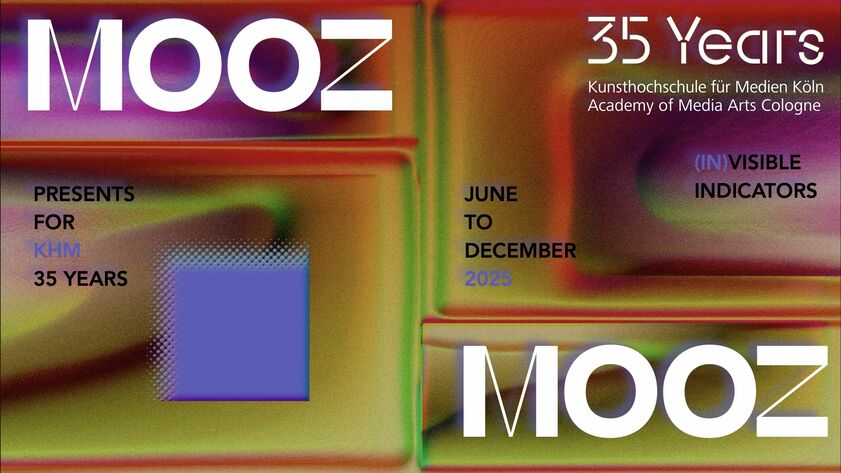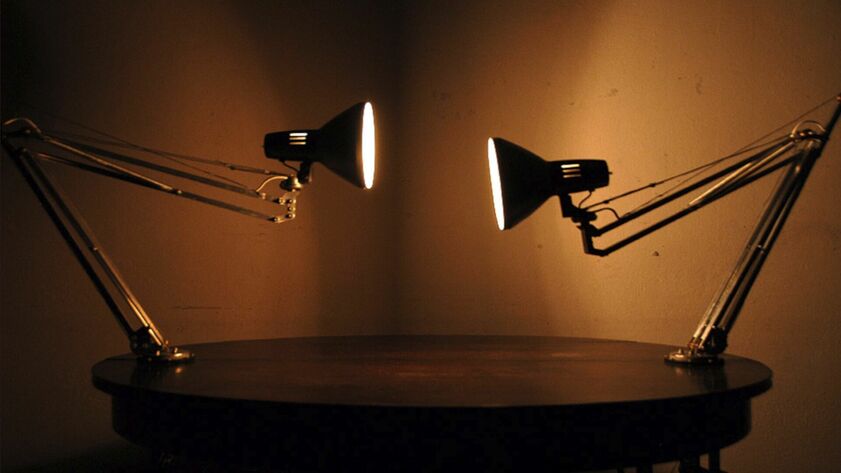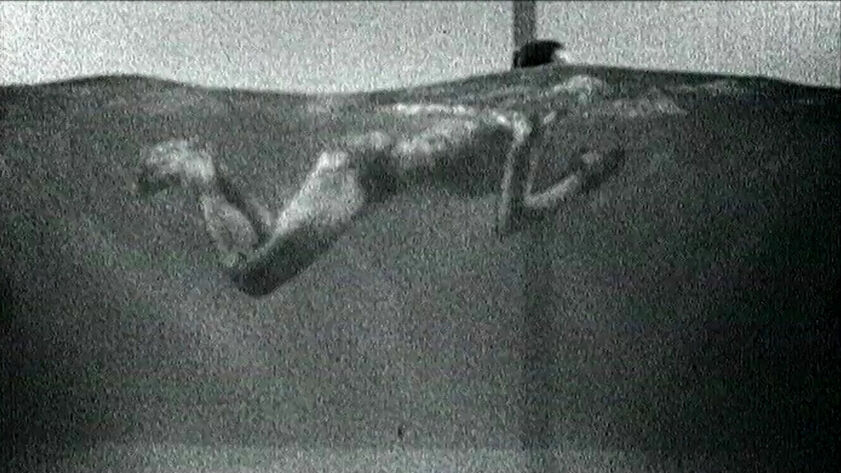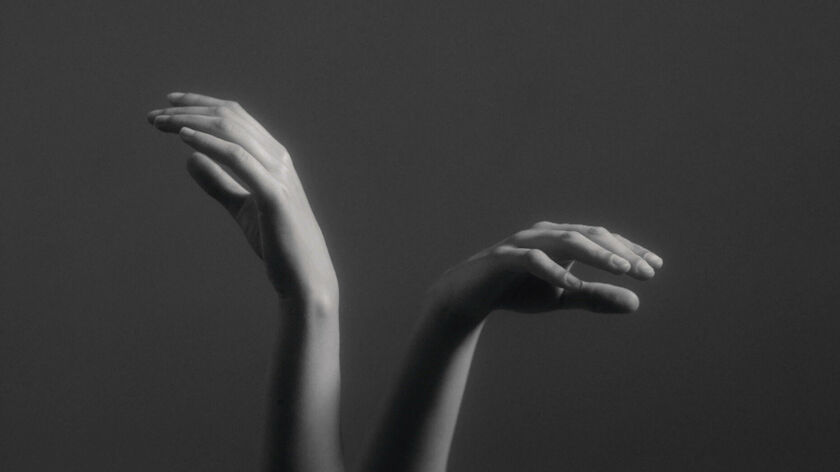Doch die große Menge an Essen ist überproportional für so ein kleines Kind. Die Mutter schließt die Vorhänge, schließt die Welt aus. Das Kind versucht einen Vogel zu füttern—mit Gewalt. Auch wenn das Kind es nicht böse meint. Genauso wird doch auch das Kind ernährt. Wir hören immer wieder eine Stimme, die verurteilt. In unserer Vorstellung wird das Kind mit diesen Wörtern gefüttert, mit diesen Ideen, genau wie wir jetzt damit gefüttert werden:
“Die da drüben lieben sich im Grünen, nicht im Haus, oder in den Schlafzimmern mit dem Licht aus. Wer weiß was sie dort treiben. Die da drüben putzen ihre Fenster nicht richtig. Die da drüben halten Vorhänge für nichtig. Die da drüben haben die falschen Narben…”
Wieder beim Putzen. Nun schauen wir, wie die Eltern Fernsehen schauen: eine Person, der durch den Bildschirm der Kopf abgeschnitten wurde, schlägt mit der Faust auf den Tisch, und wir hören dabei “Die Da Drüben” immer wieder. Der Vater streichelt das Kind, während der Chor von “Die Da Drüben” immer lauter wird. Eine Gruppe gesichtsloser Kinder sitzt scheinbar an Pulten in der Schule, sie schauen nach oben, nach unten, sie skandieren “Die Da Drüben”. Auch zwischen einem anderen Kind und unserem Protagonisten gibt es Spannungen als einer von ihnen zum “Fremden” wird. Es ist also nicht nur zuhause, es ist auch so in der Schule. Und auch im Fernsehen. Es ist in jeder Ecke der Welt. Überall liegt Intoleranz, der Hass gegen Die Da Drüben.
Unser Kinderprotagonist kommt zu seiner liebevollen Mutter nach Hause, wird von ihr umarmt, bekommt sein Essen. Wir sehen, im Splitscreen, wie “Die Da Drüben” genau das Gleiche tun. Uns wird klar gemacht, wie ähnlich sie sind—wie nahezu identisch sie sind. Zwei Mütter füttern ihre Kinder als ob sie Spiegelbilder voneinander wären. Die Stimme die wir hören kann dies aber nicht tolerieren. Die Menschen Hier können das auch nicht:
“Die da drüben haben Schatten, die sich unsere überlappen. Die da drüben gehören nicht zu unserem Nagel im Boden.”
Die Familie, die Schule, das Fernsehen sind alle Platzhalter, Metaphern für eine konstruierte Gesellschaft die auf Ausgrenzung gestützt ist. Das Kind ist klein, unschuldig. Zum Filmende jedoch, nach einem kindlichen Versteckspiel, tötet das Kind unabsichtlich ein Tier als er versucht es zu füttern—in gleicher Weise wie seine Eltern ihn füttern. Ein Liebes- und Fürsorgeversuch, in der einzigen Weise die das Kind gelernt hat. Es ist eine traurige, entsetzliche Tatsache. Unser kleines Kind “kann zwischen Liebe, Hass, und Angst nicht unterscheiden”, wie Nausheen Javed es sagt.
Them People (Die da drüben), der schöne kurze Animationsfilm mit einem sorgfältig erstellten Poem von der Künstlerin, Schöpferin und Animatorin Nausheen Javed, handelt im Wesentlichen um die wachsende Intoleranz gegenüber “dem Fremden”. Dabei geht er auch um die Selbstentfremdung, die parallel zu der Entfremdung von Anderen passiert, und um die dadurch hervorgebrachte Gewalt. Thematisiert wird die Fremdenfeindlichkeit auf einer abstrakten Ebene—und wie die Gesellschaft (ganz wörtlich) damit gefüttert ist. Die Stimme der Künstlerin spricht uns an, sie wiederholt was die Menschen hier denken über die da drüben, wie die Menschen hier die da drüben vorverurteilen. Es erinnert uns daran, wie absurd und auch gefährlich es ist, wenn wir immer wieder solche kleinen Verurteilungen, kleinen Annahmen machen.
Die Animationsform wurde bewusst gewählt, wir sehen die Schmierflecken auf den letzten Einzelbildern des Films, als ob all diese Äußerungen, all dieser Hass, mit dem wir schon von Kindheit an gefüttert wurden, eine Spur hinterlässt. Einen Fleck. Wir sollten darauf aufmerksam werden. Sonst passieren schreckliche Dinge, und diese könnten uns allen so passieren. Denn Menschen sind nicht bis ins Mark dadurch definiert ob sie von hüben oder drüben sind. All dies ist ein gewalttätiges, erfundenes Konstrukt.
“Schrecken, Schrecken, die da drüben sind überall verstreut”.
Text - Pariya Bakhshi
Nausheen Javed hat ein Studium in Bildender Kunst in New Delhi absolviert bevor sie ihren Master in Animation Film Design von der National Institute of Design in Ahmedabad aufnimmt. Ihr erster Film, Her Long Nails, von August 2014, hat sie als ihr Abschlussprojekt am National Institute of Design gefilmt. Sie arbeitete für ein Jahr als Broadcast-Designerin beim Star Network, wo sie für die von ihr gestaltete Animationswerbungen und TV-Kanäle mehrere Medienpreise erhielt.
2016 zog sie nach Deutschland um Kunst an der Kunsthochschule für Medien Köln zu studieren. Them People, am 1. Februar 2019 abgeschlossen, ist ihre Diplomarbeit und wird 2020 bei den Kurzfilmtagen in Oberhausen uraufgeführt.
Später absolvierte sie ein Master of Science in Integrated Digital Media an der New York University Tandon School of Engineering. Javed lebt heute in New York und arbeitet als multidisziplinäre Designerin, UX-UI Designerin, und Grafikdesignerin.


















